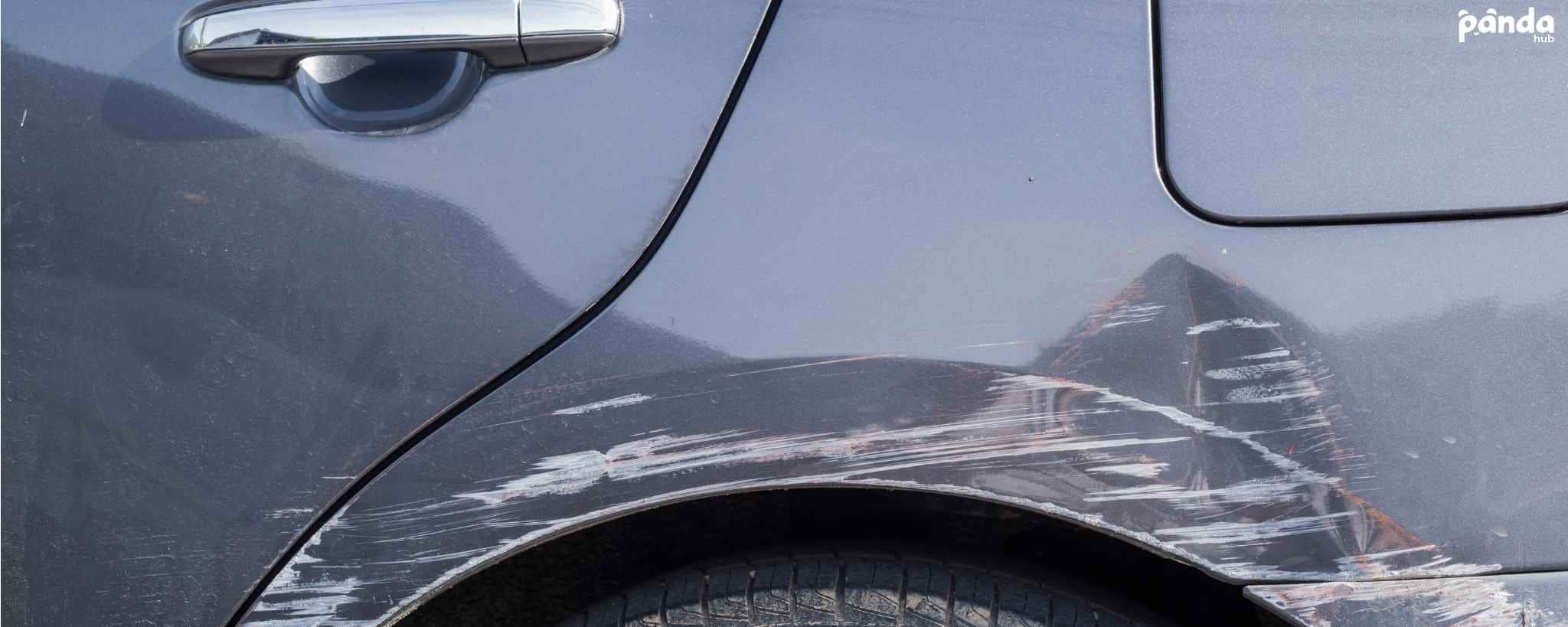Types of Car Scratches and How to Fix Them: Complete Guide
Here's how to identify and fix different types of car scratches with practical solutions, from light surface marks to deep primer damage!

Use AI to summarize this article:
A car’s exterior isn’t just a single layer of color. It’s a three-layered system designed to protect and shine. The topmost layer, the clear coat, is a glossy, transparent shield that guards the colored base coat beneath it. Below the base coat lies the primer, which bonds paint to the metal body.
Scratches vary in severity based on which layers they penetrate. Surface scratches barely graze the clear coat, while deep scratches expose the primer or even bare metal, risking rust. Knowing these layers helps you identify and treat scratches effectively, preserving your car’s look and value.
This guide explains what scratches are, their causes, and practical steps to fix different types of car scratches.
What Causes Scratches on Your Car's Paint?
Scratches don’t appear out of nowhere. Every day scenarios and small oversights often leave marks on your car’s paint. Here’s what commonly causes scratches on a car.
Improper Washing and Drying
Using a gritty sponge or a single bucket of soapy water traps dirt, dragging it across your car’s paint surface like sandpaper.
Drying with a rough towel adds fine swirl marks, especially visible on dark-colored cars.
Here’s How to Hand Wash a Car Properly
Road Debris and Environmental Factors
Tiny rocks kicked up by tires or gritty road salt in winter can nick your car’s hood or bumper. Tree branches brushing against doors during a tight parking maneuver leave faint but noticeable scratches.
Accidental Contact and Vandalism
A stray key scraped along your door panel by a passerby or a shopping cart bumping your fender in a crowded lot causes anything from light scuffs to deep gouges.
Intentional vandalism, like keying, often results in severe damage.
Detailed Guide on Fixing Keyed Cars.
Minor Collisions and Paint Transfer
Minor collisions, like lightly bumping another vehicle’s bumper or a painted barrier, can transfer foreign paint onto your car’s surface. These marks often appear as colored streaks on your car’s surface, but are usually fixable.
Types of Car Scratches Explained
The depth and appearance of the scratches determine the best way to fix them. Here are some common types of car scratches and how to fix them:
1. Surface Scratches
These are the lightest marks in the car’s surface that only affect the outer edge of the clear coat. They often appear as faint, web-like patterns, like swirl marks from improper washing.
How to Spot Surface Level Scratches
Run your fingernail over the mark. If it doesn’t catch, it’s a surface scratch.
They’re most visible under sunlight on dark cars, resembling a hazy sheen.
How to Fix Surface Scratches
- Wash the area with car soap and a clean microfiber cloth to remove dirt.
- Dry thoroughly with the microfiber towel to avoid new marks.
- Apply a light polishing compound (e.g., Meguiar’s ScratchX) with a foam applicator pad in circular motions.
- Wipe off residue with a microfiber cloth and check the scratch’s visibility.
- Seal with car wax for protection, using a soft cloth.
2. Clear Coat Scratches
These penetrate deeper into the clear coat but don’t reach the base coat. They’re more noticeable than surface scratches and are often caused by brushes or light abrasions.
How to Spot Clear Coat Scratches
Your fingernail may slightly catch, but you won’t see the car’s colored paint disrupted. They appear as distinct lines, like a faint scratch on a black car’s door.
How to Fix Clear Coat Scratches
- Clean the scratch with pH-neutral car soap and a microfiber cloth, then dry completely.
- Rub a mild abrasive compound with a foam pad for 1-2 minutes.
- Buff the area with a clean microfiber cloth until the compound is fully removed.
- Apply a clear coat-safe wax or sealant to restore shine.
- Inspect under light; repeat if faint marks remain.
3. Paint Scratches
Paint scratches cut through the clear coat into the base coat, exposing the car’s color layer. They’re deeper and more visible, often from keys, rocks, or sharp objects.
How to Spot Paint Scratches
The scratch reveals the same color as your car’s paint. Your fingernail catches noticeably, and the mark stands out.
How to Fix Paint Scratches
- Wash and dry the scratched area to remove debris.
- Sand lightly with 2000-grit wet sandpaper until the scratch feels smooth, keeping the area wet.
- Apply a color-matched touch-up paint (check your car’s paint code) with a fine brush, letting it dry for 24 hours.
- Buff with a polishing compound and a microfiber cloth to blend the paint.
- Finish with wax or sealant for a glossy look.
4. Primer Scratches (Deep Scratches)
These severe scratches reach the primer or metal, exposing gray or white layers beneath the paint. They are typically caused by significant impacts or vandalism and pose a risk of rust.
How to Spot Deep Scratches
The scratch shows a different color (gray, white, or metallic) than your car’s paint. It feels deep, like a gouge on a bumper.
How to Fix Deep Scratches
- Clean the area thoroughly with soap and water, then dry.
- Sand gently with 1500-grit wet sandpaper to smooth the edges, keeping it wet.
- Apply a primer (e.g., automotive spray primer) in thin layers, drying per instructions.
- Use color-matched touch-up paint, followed by clear coat spray. Allow each layer to dry fully.
- Buff with polishing compound and wax for a seamless finish.
Note: Deep scratches may need professional repair to prevent rust.
5. Paint Transfer Scratches
These occur when another object, like a car or pole, leaves its paint on your vehicle. They’re often scuffs with foreign color rather than deep scratches.
How to Spot Transferred Paint Scratches
Look for a colored streak that doesn’t match your car’s paint. The mark may feel raised or sticky.
How to Fix Transferred Paint Scratches
- Wash the area to remove loose debris, using a microfiber cloth.
- Apply a solvent-based cleaner (e.g., Goo Gone Automotive) to soften the foreign paint.
- Gently rub with a microfiber cloth until the transfer lifts, avoiding excessive pressure.
- Polish with a light compound to restore the clear coat’s shine.
- Wax the area for protection and inspect for lingering marks.
Pro Tip: Always test products on a small area first and work in a shaded, clean space.

Preventing Future Scratches
Preventing scratches is much easier than fixing them. These practical habits backed by automotive detailing practices will help you minimize damage and costly repairs:
Proper Washing Techniques
Use a two-bucket car wash method: one for soapy water, one for rinsing your mitt. Choose microfiber wash mitts and grit guards to trap dirt. Dry with plush microfiber towels to avoid swirl marks.
Wash in straight lines, not circles, to reduce hazing.
Protective Coatings
Ceramic coatings or paint protection film (PPF) add a durable shield to your car’s paint. In my experience, ceramic-coated vehicles show fewer micro-scratches compared to uncoated ones. Apply coatings professionally for the best results.
Smart Parking and Driving Habits
- Park away from crowded lots to avoid door dings or cart bumps.
- Use parking sensors or cameras to navigate tight spaces.
- On highways, keep a distance from gravel trucks to dodge rock chips.
- Avoid brushing against overgrown branches on narrow roads.
How Much Does Car Scratch Repair Cost?
Repair costs vary by scratch type and method. Here’s a breakdown based on industry averages in 2025.
DIY Repair Costs
- Surface scratches: $10-$30 (polish, wax, microfiber cloths).
- Clear coat scratches: $15-$50 (polishing compound, sealant).
- Paint or primer scratches: $30-$100 (touch-up paint, sandpaper, primer, clear coat).
- Paint transfer or swirls: $20-$60 (solvent, polish, polisher pads).
Professional Repair Costs
- Surface or clear coat scratches: $100-$300 for buffing and polishing.
- Paint scratches: $300-$800 for touch-up and blending.
- Primer scratches: $800-$2,500 for panel repainting or rust treatment.
- Full ceramic coating: $500-$3,000 for long-term protection.
The cost of repairing car scratches depends on location, the severity of the damage, and shop rates. Get multiple quotes for accuracy.
Common Questions About Car Scratches
Can I fix minor car scratches at home?
You can fix minor car scratches at home using polishing compounds, scratch-removal kits, and microfiber cloths. If the scratch only affects the clear coat, these tools can restore the finish. Deeper scratches may need touch-up paint and steady application to blend with the surrounding paint.
What’s the difference between scratches and scuffs on a car?
Scuffs mark the surface without cutting through the clear coat. Scratches penetrate paint layers and feel rough to the touch.
Do protective coatings prevent all scratches?
Protective coatings do not prevent all scratches. They protect against light surface damage, swirl marks, and chemical exposure, but cannot stop deep scratches from impacts or sharp objects. While coatings add durability and ease of cleaning, they are not a substitute for careful driving and maintenance.
What does a minor scratch on a car look like?
A minor scratch on a car appears as a light, shallow line that does not penetrate the clear coat. It may look like a faint scuff or swirl mark and is often only visible in certain lighting. These scratches usually feel smooth and can often be removed with polishing.
A scratch on your car, whether a small mark from a shopping cart or a deeper line that exposes metal underneath, can completely ruin how your car looks. And, if you ignore these minor scratches, they may lead to rust or affect your vehicle’s value over time.
With the right tools, like a polishing compound or a scratch repair kit from an auto body shop, you can often fix light scratches at home and restore your car’s smooth finish. For more serious damage, such as primer or base coat scratches, a professional touch ensures the best outcome. Washing your car regularly and adding a protective coating can help prevent small scratches and keep the paint in top shape. For those wanting expert care without the hassle, Panda Hub provides expert car detailing services at your convenience.

Parham Koukia
Lead Car Detailer / Operations Manager
With nearly 15 years of hands-on detailing experience, Parham has become a trusted authority in the auto care world. His work is regularly spotlighted in leading outlets like CNN, GoBankingRates, and Family Handyman. Parham likes to share his knowledge to offer in-depth tips on equipment selections, seasonal car care, and some secret car cleaning tips used by detailers in the real world!
Read more
